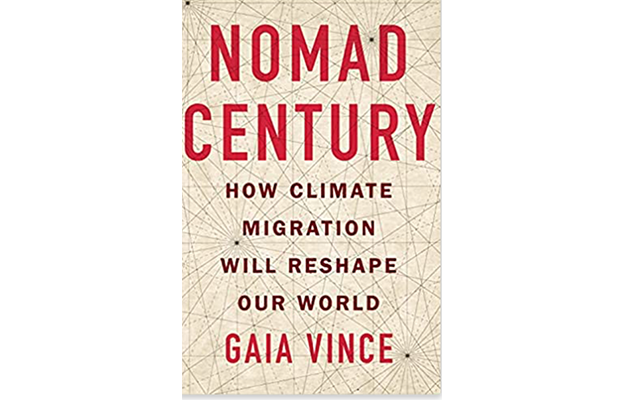Nomad Century: How Climate Migration Will Reshape Our World, by Gaia Vince. Flatiron Books, 2022. 260 p.
All over the world, millions of people are on the move. Fleeing Putin’s brutal invasion of Ukraine and the civil war in Syria. Crossing the Mediterranean from Africa to Europe in tiny, overcrowded vessels. Trekking up the spine of the Americas in a desperate effort to get into the USA. Creeping into Quebec at the unauthorized Roxham Road border point.
 Humans have always been a migratory species. People move in search of better economic opportunities, or to escape armed conflicts and repressive regimes. But as Gaia Vince declares in Nomad Century, more people than ever before will soon be required to relocate permanently from regions that will become uninhabitable due to climate change.
Humans have always been a migratory species. People move in search of better economic opportunities, or to escape armed conflicts and repressive regimes. But as Gaia Vince declares in Nomad Century, more people than ever before will soon be required to relocate permanently from regions that will become uninhabitable due to climate change.
Gaia Vince is a British science writer and broadcaster who has published two previous books on environmental topics. This new title addresses the implications of the massive human migration that is looming in the coming decades. How will we adapt to this, and how can we prepare for it?
We have already seen the worldwide effects of a warming planet: heatwaves and dangerous humidity, floods, droughts, wildfires, infectious diseases, etc. The polar icecaps are melting and sea levels are rising. Air and water pollution, soil degradation and severe weather events have reduced crop yields, resulting in life-threatening food insecurity — especially in poverty-stricken tropical regions of Africa, South Asia, Latin America and Oceania.
Currently, 55% of the world’s population resides in the relatively comfortable climate niche between 20 and 40 degrees of latitude north of the equator. But this comfort zone is moving northward at the rate of “0.42 kilometres per year, which means that’s the speed species, including humans, need to migrate away from the equator in order to enjoy the same climate conditions”.
The author reiterates the prevailing scientific consensus that we are on a path to a global temperature rise of at least doublethe 1.5 degrees Celsius target of the Paris Climate Agreement. “With every degree of temperature increase, roughly a billion people will be pushed outside the zone in which humans have lived for thousands of years. We are running out of time to manage the coming upheaval before it becomes overwhelming and deadly. Migration is not the problem, it is the solution.”
As it happens, the workforce in Europe and North America has been declining due to lower birthrates and greater longevity. “Europe’s population is set to shrink by 10% by 2050. It is also ageing. The elderly and children will outnumber workers by one-fifth by 2060.” And so large numbers of working-age immigrants will be required for these countries to maintain their economies. Canada, for example, wants to welcome 1.5 million newcomers in the next three years.
However, a sense of nationalism has provoked hostility to immigrants in many countries. Vince offers ample evidence that, contrary to the xenophobes, migrants provide substantial economic and cultural benefits wherever they settle. The nation-state, a relatively recent development in human society, often acts as a barrier to the necessary movement of peoples in search of a better life while making beneficial contributions to their new homes.
She warns that the mass resettlement of future climate migrants will not be manageable by the current piecemeal, country-by-country approach. The world is already failing to process and accommodate refugees in a timely and humane fashion. “We need a new mechanism to manage global labour mobility far more effectively and efficiently.” Agencies like the UN’s International Organization for Migration will need to be given the authority to ensure non-discrimination against migrants and their families, and to coordinate global strategies for their relocation.
Where will they all go? The Northern Hemisphere has twice as much landmass as the South, and much more of it is located in the temperate zone of the future. The author offers some interesting scenarios that would take advantage of the improving climate in northerly regions like Canada’s Territories, Alaska, Greenland and Siberia. She proposes the rapid construction of “instant cities” built on sustainable, zero-carbon principles, located in proximity to opportunities for resource development — clean water and clean energy, minerals, aquaculture, food production, etc. Several chapters describe climate-friendly best practices in housing, agriculture, transportation and power generation that could improve existing communities as well.
In my view the book doesn’t give sufficient attention to the geopolitical challenges that these enormous projects would entail. How are mass migration decisions to be made? Who pays for them? Heretofore, international climate cooperation has not lived up to its commitments. How can we move the needle on decarbonization and migration in time to forestall the worst emergencies?
Vince concludes with some analysis of climate intervention strategies like carbon capture and storage, and solar cooling (by launching reflective materials into the stratosphere). These geoengineering practices are costly and controversial, of course, running the risk of unintended consequences for the planet and its inhabitants.
Nevertheless, I think Nomad Century raises important issues, focusing on an often overlooked human impact of climate change, and offering a rich smorgasbord of potential solutions to the demographic crises that will soon face our warming world.


